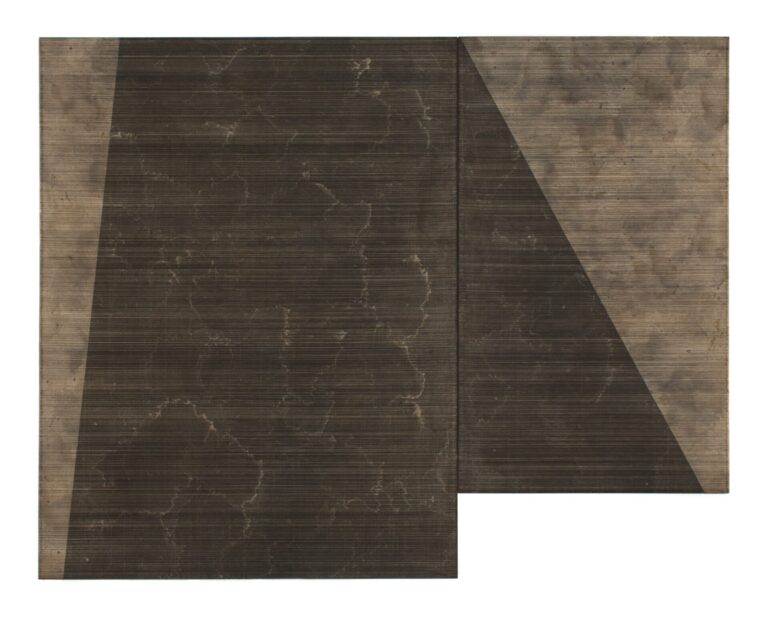Blaise Rosenthal: Sierra Madre
Sep 7 — Oct 26, 2024
Municipal Bonds is pleased to present Sierra Madre, Blaise Rosenthal’s first solo exhibition with the gallery. Featuring works spanning from 2017 to 2024, this exhibition reflects as much on the passage of time as it does on time held in place. In these paintings and drawings, Rosenthal quietly grapples with loss—the passing of his mother in late 2017 and his father a few years later—giving rise to a body of work that carries the weight of life, a sense of profound solitude, and a reverence for the familial landscape. The show comprises his central series, Monoliths, large canvases with distilled compositions that evoke solidity and endurance, alongside Stones, a subset of smaller works on paper where signs and systems take precedence.
Over these seven years, Rosenthal explores the core of his practice—employing a distinct visual language rooted in a relationship between painting and drawing, and shaped by a period of steadily honing his methods. Charcoal, earth pigments, and acrylic become tools of both precision and instinct, allowing him to express themes of memory and place with a sensitivity that is deeply personal yet universally resonant. His approach here feels like a homecoming, not just in his revisiting of familiar techniques but in the deliberate restraint with which he applies them. The works, though distilled in form, possess an expansiveness—an exploration of landscape both external and internal, where traces of time, loss, and presence are subtly layered into each piece. There is a sense of careful excavation in these paintings, as though the artist is sifting through his materials to unearth the essential elements and letting them speak with a quiet clarity that lingers long after the first encounter.
His paintings balance intimacy with expansiveness, holding in tension the idea of a landscape both vast and internal, a terrain of memory and emotion. By abutting two canvases into a single asymmetrical composition, Rosenthal emphasizes the physicality of his work. This pairing allows for a complexity that resists straightforward pictorial interpretation. The proximity of the canvases—their touching—emphasizes their material presence, creating a dynamic interplay between the atmospheric depth and compositional gesture of the surface and the raw physicality of the object.
The title Sierra Madre resonates on multiple levels within Rosenthal’s personal narrative. It speaks of the mountains—a constant in his life, from his upbringing in Northern California’s Sierra Foothills to his current home in the high country—a landscape that continues to inform his work. The weathered granite, sparse vegetation, and geology of dry peaks all find echoes in his palette, shapes, and textures. The title also nods to family lore—an early childhood spent in Mexico, where the rhythms of the natural world and life in a rainforest village left an indelible mark. His mother, a Spanish teacher and larger-than-life figure, is conjured by name. And there is a reference to the classic film The Treasure of the Sierra Madre, a favorite of the artist’s father, further deepening the pull of personal memory.
Rather than relying on conventional narrative, Rosenthal’s art engages abstraction, along with carefully considered titles for each work, as a means of storytelling. His works are not merely aesthetic objects but carriers of a personal lexicon—symbols and forms that tap into experiential archetypes, connecting with something primal yet deeply familiar. Light and dark, solidity and openness, presence and absence all coexist in his compositions that invite interpretation without imposing it. What emerges is a conversation, where the viewer is free to bring their own histories and associations, meeting the artist’s work halfway.
Guided by a self-taught journey through abstraction, Rosenthal’s practice draws not from theory or dogma but from a tactile exploration of what pigments and marks can do—how they evoke the elemental, the geological, the bodily. These works reveal themselves gradually; their layered construction invites an experience that unfolds over time. The physicality of the marks—some insistent, others ghostly—belies an intellectual rigor, a distillation of forms into what the artist describes as a singular gesture. That gesture becomes the heart of each piece, with everything else—texture, color, composition—serving as context. The process is meditative and grounded in repetition, in rhythms that feel almost natural, like erosion or sedimentation, introducing organic textures that counterbalance the geometric precision of the compositions.
For Rosenthal, who has often worked outside the immediate purview of the contemporary art world, there is a deliberate resistance to temporal trends. His focus remains on timelessness—creating work that holds a sense of the past, speaks to the present, and gestures toward a future where its relevance endures. While these works stem from deeply personal experiences, they strive to transcend the individual, reaching toward something universal. They offer a space where the artist’s story dissolves into a broader human experience—where gestures, stains, and marks carry the weight of shared histories, memories, and emotions.
Check gallery website for hours and additional info
